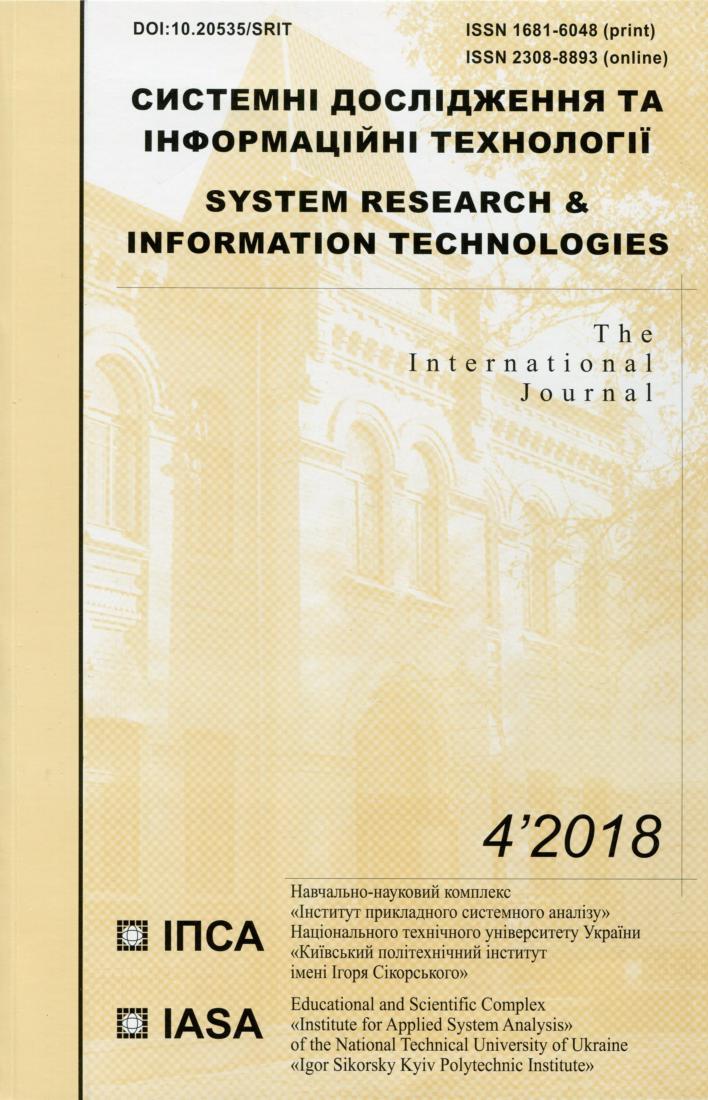Network structures and systems: III. Hierarchies and networks
DOI:
https://doi.org/10.20535/SRIT.2308-8893.2018.4.07Keywords:
complex network, network system, flow, hierarchy, model, evaluation, association, conglomerate, system environmentAbstract
The basic principles of the formation of system hierarchies and complex systems with a hierarchical network structure are analyzed. The flow adjacency matrix for a complex hierarchical network system is determined, which allows us to investigate the functional features of the system, linking them with the components of the structure. The notion of the flow core is introduced, which allows us to construct simplified models of a system of a smaller dimension with simultaneous monitoring of the quantitative measure of maintaining their adequacy. The principles of formation of information and evaluation models of complex hierarchical network systems with consideration of the priority of their components and the level of fullness of data are proposed. The main advantage of the evaluation models is the smaller amounts of information that are much easier to analyze and allow us to timely locate the most threatening components of the system. For the study of heterogeneous inter-system interactions, the notions of association, conglomerate and system environment are introduced, which allow us to analyze the nature and effects of inter-system influences of different types.References
Polishchuk O.D. Merezhevi struktury ta systemy: I. Potokovi kharakterystyky skladnykh merezh / O.D. Polishchuk, M.S. Jadzhak // Systemni doslidzhennja ta informatsijni tekhnolohiyi. — 2018. — № 2. — S. 42–54.
Polishchuk O.D. Merezhevi struktury ta systemy: II. Sertsevyny merezh ta mul'typleksiv / O.D. Polishchuk, M.S. Jadzhak // Systemni doslidzhennja ta informatsijni tekhnolohiyi. — 2018. — № 3. — S. 38–51.
Barabasi A.-L. The Architecture of Complexity / A.-L. Barabasi // IEEE Control Systems. — 2007. — Vol. 27 (4). — P. 33–42. DOI: https://doi.org/ 10.1109/MCS.2007.384127.
Pattee H. Hierarchy Theory: The Challenge of Complex Systems / H. Pattee. — New York: George Braziller, 1973. — 389 p.
Ahl V. Hierarchy Theory: A Vision, Vocabulary, and Epistemology / V. Ahl, T. Allen. — New York: Columbia University Press, 1996. — 206 p.
Rajan R.G. Financial systems, industrial structure, and growth / R.G. Rajan, L. Zingales // Oxford review of economic Policy. — 2001. — Vol. 17 (4). — P. 467–482. DOI: https://doi.org/ 10.1093/oxrep/17.4.467.
Marsan G.A. Towards a mathematical theory of complex socio-economical systems by functional subsystems representation / G.A. Marsan, N. Bellomo, M. Egidi // Kinetic and Related Models. — 2008. — Vol. 1 (2). — P. 249–278.
Allen L. Nature insight: Complex systems / L. Allen // Nature. — 2001. — Vol. 410 (241). DOI: https://doi.org/10.1038/35065672.
Pavé A. Modeling of Living Systems: From Cell to Ecosystem / A. Pavé. — New York: John Wiley & Sons, 2012. — 620 p.
Pumain D. Hierarchy in Natural and Social Sciences / D. Pumain. — Berlin: Springer Science & Business Media, 2005. — 246 p.
Simon H. The architecture of complexity: Hierarchic systems / H. Simon // Proceedings of the American Philosophical Society. — 1962. — Vol. 106. — P. 467–482.
Polishchuk D. Complex Evaluation of Hierarchically-Network Systems / D. Polishchuk, O. Polishchuk, M. Yadzhak // Automatic Control and Information Sciences. — 2014. — Vol. 2 (2). — P. 32–44. DOI: https://doi.org/10.12691/acis-2-2-1.
Scott W.R. Organizations and organizing: Rational, natural and open systems perspectives / W.R. Scott, G.F. Davis. — London: Routledge, 2015. — 464 p.
Fontoura Costa da L. The hierarchical backbone of complex networks / L. da Fontoura Costa // Physical review letters. — 2004. — Vol. 93 (9). — 098702. DOI: https://doi.org/10.1103/PhysRev Lett.93.098702.
Ravasz E. Hierarchical organization in complex networks / E. Ravasz, A.-L. Barabási // Physical Review E. — 2003. — Vol. 67 (2). — 026112. DOI: https://doi.org/10.1103/Phys RevE.67. 026112.
Polishchuk D.O. Kompleksne determinovane otsinjuvannja skladnykh iyerarkhichno-merezhevykh system: I. Opys metodyky / D.O. Polishchuk, O.D. Polishchuk, M.S. Jadzhak // Systemni doslidzhennja ta informatsijni tekhnolohiyi. — 2015. — № 1. — S. 21–31.
Schwenk H. Teradata Universe: Regaining Focus / H. Schwenk. — 2017. — 5 p. — Available at: http://www.idc. com/getdoc.jsp?containerId=EMEA42717517.
Hilbert M. How much information is there in the “information society”? / M. Hilbert // Significance. — 2012. — Vol. 9 (4). — P. 8–12. DOI: http://dx.doi.org/ 10.1111/j.1740-9713.2012.00584.x.
Chessell M. Common Information Models for an Open, Analytical, and Agile World / M. Chessell, G. Sivakumar, D. Wolfson et al. — New York: IBM Press, 2015. — 240 p.
Khabsa M. The Number of Scholarly Documents on the Public Web / M. Khabsa, C.L. Giles // PLoS ONE. — 2014. — Vol. 9 (5). — e93949. DOI: https://doi.org/10.1371/journal.pone.0093949.
Bawden D. The dark side of information: overload, anxiety and other paradoxes and pathologies / D. Bawden, L. Robinson // Journal of information science. — 2008. — Vol. 35 (2). — P. 180–191. DOI: https://doi.org/10.1177/0165551508095781.
Polishchuk D.O. Kompleksne determinovane otsinjuvannja skladnykh iyerarkhichno-merezhevykh system: II. Lokal'ne ta prohnostychne otsinjuvannja / D.O. Polishchuk, O.D. Polishchuk, M.S. Jadzhak // Systemni doslidzhennja ta informatsijni tekhnolohiyi. — 2015. — № 2. — S. 26–38.
Polishchuk D.O. Kompleksne determinovane otsinjuvannja skladnykh iyerarkhichno-merezhevykh system: III. Ahrehovane otsinjuvannja / D.O.Polishchuk, O.D. Polishchuk, M.S. Jadzhak // Systemni doslidzhennja ta informatsijni tekhnolohiyi. — 2015. — № 4. — S. 20–31.
Polishchuk D. About Evaluation of Complex Dynamical Systems / D. Polishchuk, O. Polishchuk // Journal of Complex Systems. — 2013. — Vol. 2013, Article ID 204304. — 6 p. — Available at: http://dx.doi.org/ 10.1155/2013/204304.
Polishchuk D.O. Kompleksne determinovane otsinjuvannja skladnykh iyerarkhichno-merezhevykh system: IV. Interaktyvne otsinjuvannja / D.O. Polishchuk, O.D. Polishchuk, M.S. Jadzhak // Systemni doslidzhennja ta informatsijni tekhnolohiyi. — 2016. — № 1. — S. 7–16.
Polishchuk O.D. Vybir optymal'nykh rezhymiv funktsionuvannja skladnykh dynamichnykh system / O.D. Polishchuk // Mat. metody i fiz.-mekh. polja. — 2005. — Vyp. 48 (3). — S. 62–67.
Polishchuk O.D. Pro vybir optymal'noyi dynamichnoyi systemy z klasu ekvivalentnykh system / O.D. Polishchuk // Vidbir i obrobka informatsiyi. — 2004. — Vyp. 20 (96). — S. 23–28.
Markou M. Novelty detection: a review – part 1: Statistical approaches / M. Markou, S. Singh // Signal Processing. — 2003. — Vol. 83 (12). — P. 2481–2497. DOI: https://doi.org/10.1016/j.sigpro. 2003.07.018/.

